8 Using the Practical Reasoning Perspective to Effectively Advocate in Family & Consumer Sciences/Human Sciences
Learning Objectives
Learners will be able to:
- Explain the distinctions between advocacy and lobbying, including their purposes, focus areas, and activities, and articulate why understanding these differences is essential for FCS professionals.
- Evaluate the role of advocacy in empowering individuals, families, and communities, promoting social justice, and addressing systemic inequalities through equitable access to resources and services.
- Utilize the practical reasoning framework to develop strategic action plans for addressing issues impacting individuals, families, and communities.
- Identify and apply effective advocacy tools, such as public awareness campaigns, storytelling, grassroots organizing, and policy analysis, to enhance civic engagement and influence decision-making.
- Conduct legislative and policy analyses to evaluate the short- and long-term impacts of proposed or existing policies on individuals and families, using tools like the Five I’s Policy Analysis Framework.
- Design strategies for collaborating with stakeholders, including policymakers, community organizations, and professional associations, to amplify advocacy efforts and achieve shared goals.
- Reflect on ethical principles in advocacy and utilize credible data, research, and personal narratives to create compelling and informed arguments that address societal challenges in FCS.
Why is advocating for improving the human condition in Family & Consumer Sciences/Human Sciences important? It is important for several reasons:
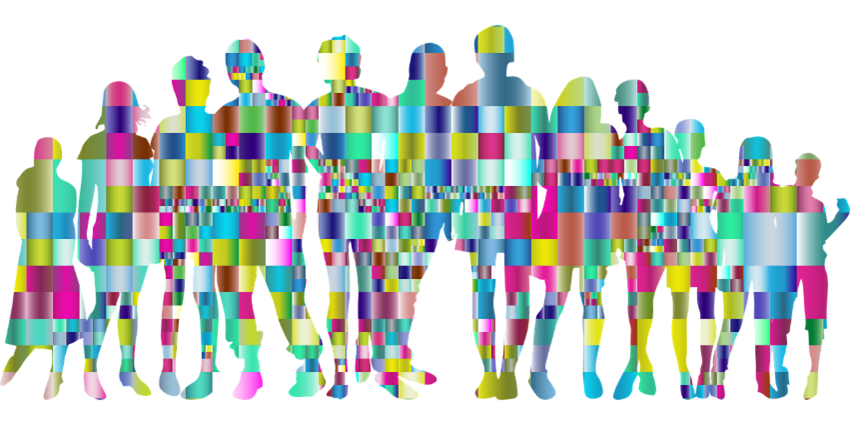
Source: https://pixabay.com/vectors/human-family-diversity-geometric-7110086/
-
- Empowerment: Advocacy empowers individuals, families, and communities by giving them a voice and enabling them to express their needs, concerns, and aspirations. It helps them to assert their rights, access resources, and actively participate in decision-making processes that affect their lives.
- Social Justice: Advocacy plays a crucial role in promoting social justice and equality. It seeks to address systemic issues, discrimination, and inequalities that certain individuals, families, or communities may face. By advocating for their rights, fair treatment, and opportunities, advocacy works towards creating a more just and equitable society.
- Access to Resources and Services: Many individuals, families, and communities may face barriers in accessing essential resources and services, such as healthcare, education, housing, or employment. Advocacy works to eliminate these barriers and ensure equitable access for all. It helps identify gaps in services, raise awareness about unmet needs, and push for policies and reforms that can address these issues.
- Community Development: Advocacy contributes to the development and well-being of communities. By addressing community-wide concerns and mobilizing collective action, it fosters social cohesion, resilience, and positive change. Advocacy efforts can lead to improved infrastructure, increased public safety, enhanced education opportunities, and better overall quality of life for community members.
- Prevention and Early Intervention: Advocacy plays a vital role in preventing problems and intervening early to address emerging issues. By raising awareness, educating the public, and promoting preventive measures, advocacy can help individuals and families avoid or mitigate negative outcomes. This proactive approach can save costs, reduce societal burdens, and promote long-term well-being.
- Amplifying Voices: Advocacy amplifies the voices of marginalized or underrepresented individuals, families, and communities who may be overlooked or disregarded by those in positions of power. It provides a platform for their stories, experiences, and perspectives, bringing attention to their unique challenges and needs. Through advocacy, marginalized groups can exert influence, challenge stereotypes, and promote inclusivity.
Advocating in the FCS/Human Sciences profession is not a one-time event or process but, rather, it is an ongoing process to draw awareness to societal issues impacting individuals, families, and communities every day. Examples include advocating for affordable child care, affordable housing, food security, financial security, and/or ensuring secondary FCS programs remain sustainable in local school districts for years to come. Advocacy can take many shapes and the ultimate goal of this chapter is to build community and engage human sciences professionals in bringing individuals, families, and communities together so they can create shared visions and plans of action; develop and expand their skills in deliberation; and become more confident in their ability to frame issues, find common ground, take actions, and remain valued members of the community. Therefore, this chapter will explore the differences between advocacy and lobbying, describe effective advocacy tools to better understand civic engagement, provide information on how to find accurate data that strengthens advocacy efforts, and show how to effectively apply the practical reasoning process using a strategic action plan when advocating for individuals, families, and communities.
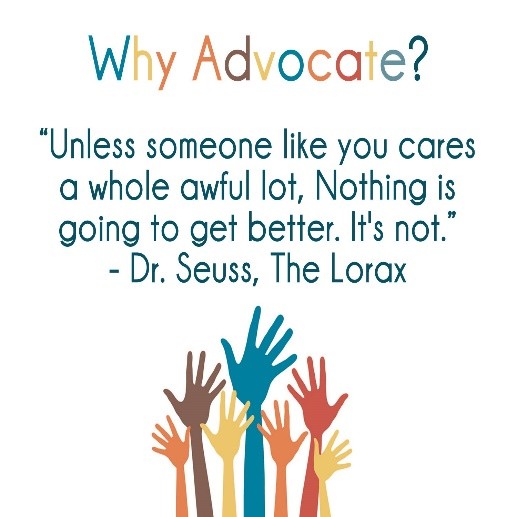
Exploring the Difference Between Advocacy and Lobbying
Since the human sciences profession is driven by the mission to improve the human condition, becoming an engaged and informed human sciences professional should be a priority considering the numerous perennial and emerging problems affecting the well-being of individuals, families, and communities in our society today. Before we can become effective advocates, we need to better understand the difference between advocacy and lobbying.
Advocacy refers to the act of actively supporting, promoting, and defending a cause, idea, or group of people (AAFCS, 2019; Bogenschneider, 2014). It involves speaking up and taking action to bring about positive change, raise awareness, and influence public opinion or policy decisions. Advocacy can take various forms, including lobbying, campaigning, organizing protests or demonstrations, writing letters or petitions, engaging in public speaking, and using various media platforms to amplify voices and convey messages.
Advocacy is often driven by a desire to address social, political, or environmental issues and to promote justice, equality, and human rights (Bogenschneider, 2014). It can be carried out by individuals, grassroots organizations, non-profit groups, professional associations, or larger entities like corporations or governmental bodies. The ultimate goal of advocacy is to bring about tangible improvements in society by challenging existing norms, policies, or practices, and by championing the rights and interests of marginalized or vulnerable populations (Bogenschneider, 2014).
Successful advocacy requires effective communication, strategic planning, collaboration with like-minded individuals or organizations, research and data analysis, and the ability to navigate political or social systems. It plays a crucial role in shaping public discourse, influencing public opinion, and creating a more inclusive and equitable society.

Source: https://pixabay.com/illustrations/social-media-faces-social-networks-550766/
Lobbying is the practice of attempting to influence or persuade government officials, legislators, or policymakers to take a particular course of action or adopt specific policies, laws, or regulations (AAFCS, 2019; Bogenschneider, 2014). Lobbying involves advocating for a particular interest or viewpoint on behalf of individuals, organizations, or industries to shape public policy decisions in their favor.
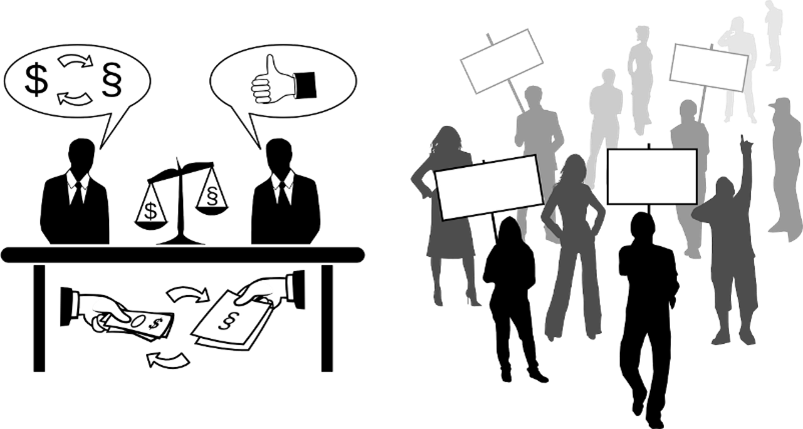
Source: https://pixabay.com/vectors/lobbying-blackmail-business-161689/
Lobbying activities can include meeting with lawmakers, providing them with information and data, presenting arguments and evidence, organizing events or campaigns, drafting legislation or policy proposals, and engaging in various forms of advocacy to advance the desired outcomes. Lobbyists often possess expertise in the areas they are representing and use their knowledge to make persuasive arguments and build relationships with policymakers (Bogenschneider, 2014; Jackson, 2014).
The goal of lobbying is to influence the decision-making process by providing information, research, and arguments that support a particular perspective. Lobbyists may represent diverse interests, such as businesses, trade associations, non-profit organizations, advocacy groups, or professional associations. Lobbying can occur at the local, state, national, or international levels, depending on the scope and impact of the issues being addressed.
It’s important to note that lobbying activities can vary significantly in terms of their transparency, legality, and ethical standards (Bogenschneider, 2014; Jackson, 2014). In many jurisdictions, lobbying is regulated to ensure transparency, prevent corruption, and maintain the integrity of the policymaking process. Laws and regulations surrounding lobbying activities differ across countries, and organizations engaging in lobbying often need to comply with specific disclosure and reporting requirements. Below is a table outlining the key differences between advocacy and lobbying (AAFCS, 2019; Jackson, 2014):
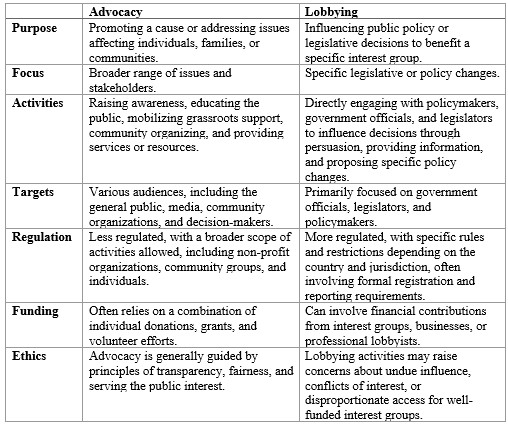
It’s important to note that the line between advocacy and lobbying can sometimes be blurry, as there may be overlaps in their activities and goals. Additionally, the specific regulations and definitions can vary across countries and jurisdictions.
Effective Advocacy Tools
When advocating for individuals, families, and communities, it is important to know and understand the tools and strategies available to become effective advocates. Some common ones include public awareness campaigns, grassroots organizing, lobbying and policy advocacy, strategic alliances and partnerships, research and data analysis, community education and workshops, media engagement, legislative and policy analysis, collaboration with experts and professionals, and advocacy training and capacity building.
Public Awareness Campaigns
Public awareness campaigns are coordinated efforts to inform and educate the public about a particular issue, cause, or topic. It aims to raise awareness, shape public attitudes, and promote behavior change or social action. Public awareness campaigns are typically conducted by organizations, government agencies, non-profit groups, or advocacy initiatives.
The purpose of a public awareness campaign can vary depending on the specific issue at hand. It may seek to:
- Educate the public about a specific problem or challenge.
- Increase knowledge and understanding of a particular issue.
- Change attitudes and perceptions towards a certain topic.
- Encourage behavior change or adoption of certain practices.
- Promote social action or advocacy efforts.
- Mobilize public support for a cause or policy.
- Reduce stigma or misconceptions associated with a specific issue.
- Raise funds or generate resources for a particular cause.
Public awareness campaigns employ various strategies and tactics to reach their target audience effectively. These can include:
- Mass Media: Using television, radio, print media, and online platforms to disseminate messages, visuals, and stories related to the campaign. This may involve creating commercials, advertisements, articles, or infographics.
- Social Media and Digital Platforms: Leveraging social media platforms, websites, blogs, and online communities to engage with the public, share information, and encourage participation. This can include creating hashtags, organizing online events, or utilizing influencers to amplify the campaign’s reach.
- Public Events and Outreach: Conducting public events, community gatherings, workshops, or seminars to directly engage with the target audience. These events provide an opportunity to share information, answer questions, and create a sense of community around the campaign.
- Partnerships and Collaborations: Working with other organizations, influencers, celebrities, or community leaders who have a stake in the issue or can help amplify the campaign’s message. Collaborative efforts can enhance reach, credibility, and impact.
- Storytelling and Personal Narratives: Using real-life stories, testimonials, or personal narratives to create an emotional connection and highlight the impact of the issue on individuals or communities. Storytelling can help humanize the campaign and make it relatable to the audience.
- Public Service Announcements (PSAs): Developing and disseminating short videos or audio messages that convey key campaign messages. PSAs are often aired on television, radio, or online platforms and aim to reach a wide audience.
- Advocacy and Activism: Mobilizing advocates and activists who actively support the cause or issue to engage in advocacy efforts, demonstrations, petitions, or other forms of direct action. This can help generate public attention and momentum for the campaign.
- Educational Materials and Resources: Develop informational brochures, fact sheets, toolkits, or online resources that provide detailed information about the issue, solutions, and available support services. These materials empower the public to take action or seek further information.
Public awareness campaigns play a vital role in addressing societal issues, promoting public health, advocating for social justice, and driving engagement and action within communities. We provide three public awareness examples that can be utilized in advocating for issues affecting individuals and families for improving their conditions.
An example of a current public awareness campaign conducted by the National Partnership for Recruiting, Preparing, and Supporting Family & Consumer Sciences Educators (2018) is the “Say Yes to FCS” campaign. The purpose of this campaign is to educate, recruit, and prepare potential secondary and postsecondary learners for obtaining an FCS Education degree due to the increasing shortage of FCS educators across the nation. Therefore, the campaign is designed to:
- Produce and/or distribute resources and information related to educator preparation and certification, professional development, and curriculum and instruction;
- Promote FCS workforce opportunities to wide audiences for recruitment of diverse candidates;
- Share faculty, courses, and learners on a national level to provide online FCS content-related pedagogy courses needed for educator licensure; and
- Provide targeted support in regions with limited FCS educator programs (National Partnership for Recruiting, Preparing, and Supporting FCS Educators, 2018, p.1).
More information and resources on this campaign can be found at https://www.fcsed.net/home.
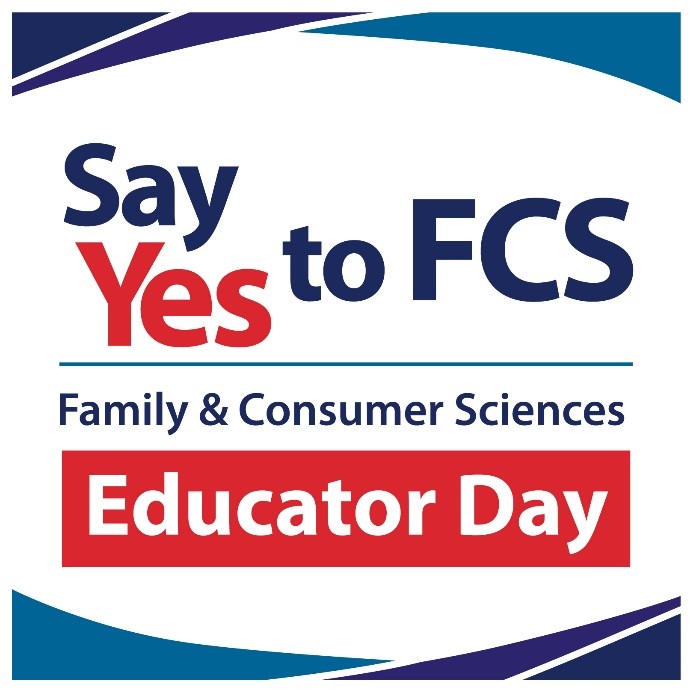
Advocacy Training
In crafting an advocacy training event that provides a coherent legislative message, an example checklist is provided in the table below to effectively reach policymakers at the local, state, and national levels (Saunders, 2003).
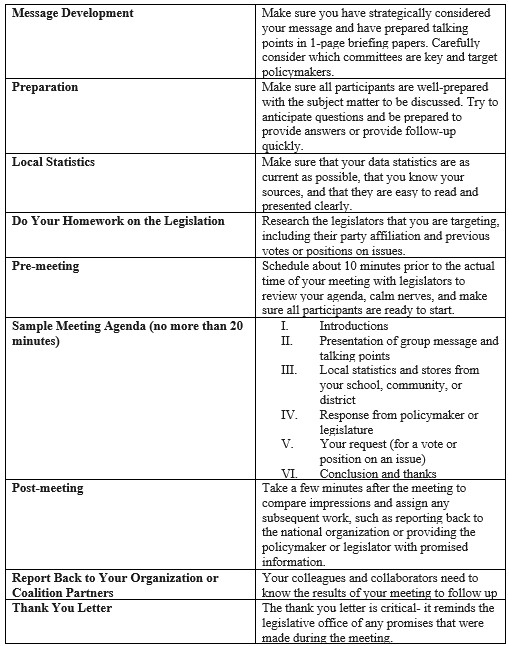
Storytelling and Personal Narratives
Another public awareness campaign method that can have a profound impact on advocacy efforts is providing a powerful and relatable way to communicate messages, evoke emotions, and inspire action through storytelling and personal narratives. This is using real-life stories, testimonials, or personal narratives to create an emotional connection and highlight the impact of the issue on individuals or communities. Storytelling can help humanize the campaign and make it relatable to the audience. Here are some ways storytelling and personal narratives influence advocacy:
- Emotional Connection: Stories and narratives have the ability to touch people’s hearts and evoke emotions. By sharing personal narratives, testimonials, or stories of individuals or communities affected by an issue, advocates can create a strong emotional connection with their audience. This emotional resonance can motivate empathy, compassion, and a desire to take action.
- Humanizing Complex Issues: Many advocacy issues can be complex or abstract, making it challenging for people to fully grasp their significance. Stories make these issues tangible and relatable by putting a face and a personal experience behind them. Through storytelling, advocates can humanize the impact of an issue, making it more understandable and compelling for others.
- Building Empathy and Understanding: Stories have the power to foster empathy and understanding by providing different perspectives and shedding light on the lived experiences of others. Hearing personal stories can help break down stereotypes, challenge biases, and promote a deeper understanding of the challenges and needs faced by individuals, families, or communities.
- Creating a Sense of Urgency: Stories can convey a sense of urgency and mobilize action. When people connect emotionally with a story, they are more likely to feel a sense of urgency to address the issue at hand. Stories can highlight the consequences of inaction and inspire a call to action, encouraging individuals to get involved, support a cause, or advocate for change.
- Amplifying Marginalized Voices: Stories have the ability to amplify the voices of marginalized or underrepresented individuals and communities. They provide a platform for those whose perspectives may be overlooked or ignored. By sharing their stories, advocates can bring attention to their unique challenges, struggles, and needs, giving them a voice and increasing their visibility.
- Building Support and Solidarity: Stories have the power to build connections and foster a sense of solidarity among diverse groups of people. When individuals hear stories that resonate with their own experiences or values, they are more likely to identify with the cause and support advocacy efforts. Shared stories can unite people around a common purpose, creating a collective movement for change.
- Influencing Decision-Makers: Stories can be a compelling tool to influence decision-makers and policymakers. Personal narratives can provide firsthand accounts of the impact of policies or the need for change. Decision-makers are often moved by these stories, as they humanize the issues at hand and highlight the real-world implications of their decisions.

Source: https://pixabay.com/illustrations/storytelling-fantasy-imagination-4203628/
By harnessing the power of storytelling and personal narratives, advocates can effectively communicate their messages, drive change, and create a meaningful impact in their advocacy efforts. Below is a list of storytelling tips provided by the American Association of Family & Consumer Sciences (2023):
“Always tell a story. As a family and consumer sciences professional, you see the human impact of laws and policy every day. You witness the successes when learners or clients receive the education they need and the problems that result when they don’t. Make these experiences come alive for legislators, decision-makers, and others who don’t get to see what you see. Data can overwhelm people. Too many numbers and details can cause eyes to glaze over.
It doesn’t matter whether you’re meeting a senator’s aide, talking to a reporter, or speaking at a rally, a good story about a learner or family will make your point about family and consumer sciences. Stories will help lay audiences connect emotionally with your argument, something that the best statistics and research findings can’t do on their own. Here are some tips for telling a family or learner story that is clear and compelling:
- Don’t start with a stereotype. Think about your listener’s point of view, frame of reference, and values.
- Rely on everyday language as opposed to technical terms and acronyms. Imagine you are talking to a friend outside your field. If your story hinges on a word or phrase that might be unfamiliar to the general public, define it briefly. Some examples: Instead of FCS, say family and consumer sciences.
- Provide a few details about your learner or client to help your audience envision the person. How old was s/he? Did s/he have children or a partner? A career? What emotions did s/he show? What was s/he most concerned about? Be sure to use a pseudonym for her/him—so privacy will be protected and the story will be more memorable.
- Quote or paraphrase your learner or client. If a learner or parent says something that impresses you, try to remember it or write it down. Incorporate their words into your story, and she will come alive for your audience.
- Surprise your listeners. Unusual details will make your story memorable. Images like these will stay with your listeners.
- Let your passion show. Don’t be afraid to include your own emotional reaction to your learner’s or client’s situation. Audiences will respond to your sincerity and conviction.
- Keep it short and sweet. You might not need more than a few well-chosen sentences to make your story effective.
- If you don’t have a relevant story, tell a story from another colleagues. “Another educator told me about one of her learners who . . .”
- Connect the dots; provide the larger system and program context. Your story should tell how your human sciences program made a difference in this person’s life; not just how one individual “pulled themselves by bootstraps.”
Support your story with a one-page, overall data summary about your total program and its impact. Your story is one example of your overall impact. Be accurate. Your story will soon be told by that legislator.” Source: Human Sciences Storytelling Tips.
An important component of storytelling and personal narratives is the advocacy impact on private value versus public value stories. Private value stories may be internal in nature or ones that an organization has an objective to help solve. Public value stories are greatly needed in the human sciences profession because these stories help inform decision-makers on what problems are being solved in the community by human sciences professionals. Franz and Ginkel (2011) state that “the most challenging step in this process is developing the public value story based on a public view driven by credible evidence” (p. 54). Below is a chart developed by Franz and Ginkel (2011) that compares private value versus public value.
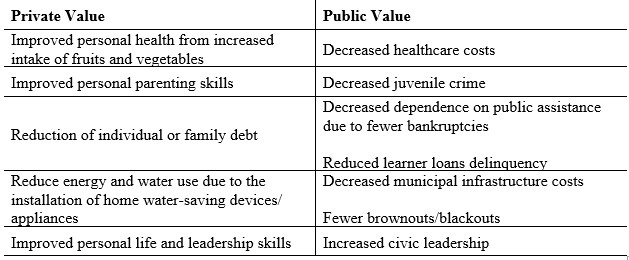
Franz and Ginkel (2011) state that “our culture demands proof of the value of human sciences” (p. 53). Human science professionals know that their work is needed and hopefully valued in their setting of practice. However, some human sciences professionals may work in heavily, publicly funded areas such as extension services. Those that work in this setting may often find themselves having to show value in their work, the return on investment, and proof of outcomes (Franz & Ginkel, 2011).
When human science professionals tell stories about successes they have experienced in their community that are a direct result of a particular workshop or program they conducted, this can help share the value of human sciences with those that are listening. Some stories need to be retold over and over until stakeholders hear the information (Franz & Ginkel, 2011). There is a link between storytelling and the practical reasoning perspective. The practical reasoning perspective allows the learner to think about a solution to a problem that they may be facing.
What should be done about…?
How will I solve this problem?
What steps need to be taken before beginning?
What do I want my outcome to be?
What is it concisely that I want to communicate?
Storytelling is an effective advocacy tool that allows someone to share their experience while applying the practical reasoning perspective for the purpose of influencing the policymaker when they hear or read the story. Once the outcome is known whether there is a desired outcome or one not expected, this experience can be shaped into a story that impactfully showcases the importance of the human sciences profession.
Legislative and Policy Analysis
Legislative and policy analysis is essential in human sciences for several reasons. First, legislative and policy analysis allows human sciences professionals to assess the impact of proposed or existing policies on individuals, communities, and society (Bogenschneider, 2014). It involves examining the goals, provisions, and potential consequences of policies, enabling professionals to understand how they align with social welfare, human rights, and equity principles. By conducting thorough analyses, human sciences professionals can identify potential strengths, weaknesses, and unintended consequences of policies.
Second, legislative and policy analysis is grounded in evidence-based practices and research. Human sciences professionals bring their expertise to analyze policies in light of existing knowledge and research findings (Bogenschneider, 2014). This ensures that policy decisions are based on reliable data, empirical evidence, and best practices, rather than solely on ideological or political considerations. By providing evidence-informed insights, human sciences professionals can contribute to more effective and impactful policies.
Third, legislative and policy analysis is a critical component of policy advocacy and development. Human sciences professionals can use their analytical skills to assess the need for policy change, evaluate alternative policy options, and propose evidence-based solutions. By conducting thorough analyses, they can make persuasive arguments, develop policy recommendations, and actively contribute to shaping policies that address societal challenges and promote social well-being (Bogenschneider, 2014).
Fourth, legislative and policy analysis helps in monitoring and evaluating the effectiveness of policies over time. Human sciences professionals can assess whether policies are achieving their intended outcomes, identify areas for improvement, and recommend necessary adjustments. Through ongoing analysis, they can ensure that policies remain responsive to changing social dynamics, emerging research, and evolving societal needs (Bogenschneider, 2014).
Lastly, human sciences professionals play a crucial role in policy implementation and impact assessment. They can analyze how policies are being implemented, examine their effects on different populations, and identify any disparities or unintended consequences (Bogenschneider, 2014). This information is vital for policymakers and stakeholders to understand whether policies are achieving their desired goals and whether they need to be adjusted or refined. By employing their analytical skills, human sciences professionals contribute to the development of effective and equitable policies that improve the well-being of individuals, families, and communities.

Source: https://create.vista.com/unlimited/stock-photos/113664254/stock-photo-judge-hammer-and-documents/
Therefore, it is important to have an effective advocacy tool for assessing legislation and policies at the locate, state, and/or national levels that are weakening the well-being of individuals and families. The Five I’s Policy Analysis Organizing tool was developed by Dr. Bonnie Braun for AAFCS in 2005 to provide human sciences professionals with a systematic approach for evaluating and assessing policies and legislation. This tool helps gather the facts, summarize the issues, and analyze intentional and unintentional outcomes, as well as long- and short-term consequences for the people who will be impacted by the policy or legislation. Below is the framework for addressing several key questions regarding a policy or legislation that helps human science professionals see why this policy or legislation is negatively impacting individuals and families. Each category begins with the letter “I” and is an effective and organized way to remember the information being analyzed regarding that policy or legislation.
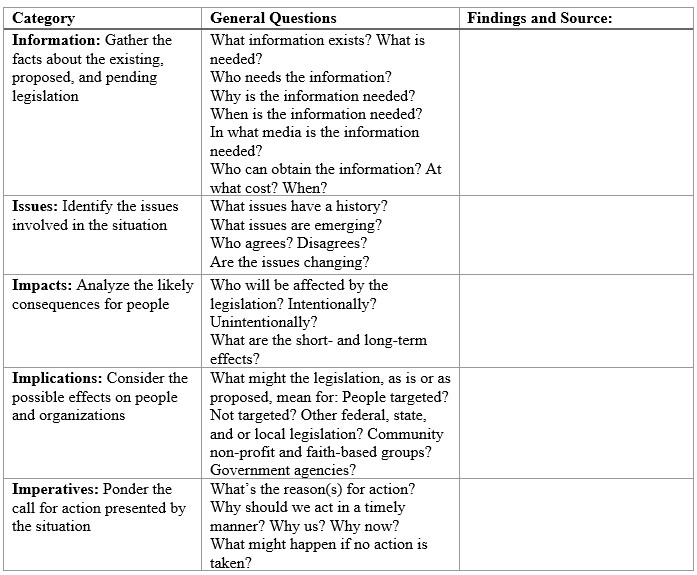
The Five I’s Policy Analysis Organizing Tool enables human sciences professionals to influence public decision-making, bridge the gap between research and practice, address societal challenges, enhance public understanding, and fulfill their professional responsibilities.
Advocacy at the Legislative Level
There has been a renewed interest in “bringing back home economics” by various news outlets and opinion articles in popular newspapers. For example, in an article published by NPR (2018) titled, “Despite A Revamped Focus on Real-Life Skills, ‘Home Ec’ Classes Fade Away,” Danovich interviews FCS teacher educators and administrators who share their reasons for why society is not aware of the Family & Consumer Sciences teaching profession, as well as why this field is needed in our education system today. This is why legislative advocacy is not only needed at the local level but also at the state and federal levels. Human sciences professionals can engage in legislative advocacy through various strategies and actions:
- Stay Informed: Stay updated on legislative processes, proposed bills, and policy discussions relevant to the human sciences field. Monitor legislative agendas, committee hearings, and policy briefings to identify opportunities for engagement. In Texas, an advocacy playbook was developed and provided through the League of Women Voters (https://my.lwv.org/sites/default/files/tx_adv_playbk.pdf) that guides engaged citizens in understanding how to stay informed on what is happening during a legislative session. There may be a similar legislative advocacy guide provided in your state.
- Build Relationships: Establish relationships with legislators and their staff members. Attend town hall meetings, legislative forums, and public hearings to connect with policymakers. Cultivate relationships based on trust, credibility, and mutual respect by inviting them to your workplace. Offer your expertise and serve as a resource for legislators on human sciences issues. If you’re not sure which legislator represents you at the state and/or federal level, you can click on this link to find out: https://www.usa.gov/elected-officials.
- Provide Testimony: Offer expert testimony during legislative committee hearings. Present evidence-based research, data, and best practices to support or oppose specific policies or bills. Clearly articulate the potential impacts of proposed legislation on individuals, communities, and the overall well-being of society.
- Develop Policy Briefs: Prepare concise and accessible policy briefs that synthesize research findings and provide recommendations. Share these briefs with legislators, policymakers, and their staff to inform their decision-making. Emphasize the relevance and implications of human sciences research to support your advocacy efforts. Examples of policy briefs related to human sciences are available on the National Council on Family Relations website at https://www.ncfr.org/policy/research-and-policy-briefs.
- Form Coalitions and Partnerships: Collaborate with like-minded organizations, advocacy groups, and stakeholders to amplify your advocacy efforts. Form coalitions to collectively advocate for policies that align with the human sciences profession’s goals and values. Work together to develop joint statements, organize events, and pool resources to maximize impact.
- Engage in FCS Education: Conduct FCS education initiatives to raise awareness and understanding of human sciences issues among legislators and the broader public. Organize informational sessions, workshops, and webinars to disseminate research findings, promote evidence-based practices, and address misconceptions.
- Mobilize Grassroots Advocacy: Encourage and mobilize individuals and communities affected by human sciences issues to engage in advocacy. Provide them with the necessary tools, resources, and guidance to contact their legislators, write letters, make phone calls, or attend legislative visits or rallies. Grassroots advocacy can have a powerful influence on policymakers.
- Support Policy Development: Actively participate in policy development processes. Offer your expertise in working groups, task forces, or advisory committees convened by legislators or government agencies. Contribute to the formulation and refinement of policies by providing evidence-based insights and recommendations.
- Collaborate with Professional Associations: Join and actively engage with professional associations related to the human sciences field, such as the American Association of Family & Consumer Sciences (AAFCS). These associations often have policy committees or advocacy initiatives through which professionals can contribute to legislative advocacy efforts collectively.
- Engage with Media: Utilize various media platforms to raise awareness of human sciences issues and advocate for policy change. Write opinion pieces, give interviews, or contribute to relevant publications. Use social media to share research findings, policy briefs, and advocacy messages, reaching a broader audience and influencing public opinion.
Remember that legislative advocacy is an ongoing process, and building relationships takes time. Consistency, persistence, and effective communication are key to successful legislative advocacy efforts as a human sciences professional.
Finding Accurate Data
In today’s world, there is access to so much data on the Internet that it may be hard to distinguish what is fact from fiction. When advocating for human sciences, it is important to have reliable and accurate data that can back up claims being made. Think of a time when you might have questioned statistical statements that someone was stating as a fact. What steps did you take to ensure the data was reliable and accurate? Having factual data enhances the credibility of advocacy efforts. When advocating for policies or presenting evidence-based arguments, having reliable and up-to-date data strengthens the legitimacy of your claims. Policymakers, stakeholders, and the public are more likely to trust and consider information that is supported by robust and accurate data. Below are some examples of websites that contain information. Policymakers rely on accurate data to understand the scope and impact of social issues, identify trends, and evaluate the effectiveness of potential policy solutions.
There are several reputable sources where you can find factual data related to the human sciences profession:
- Government Agencies at the national, state, and local levels often collect and publish data related to human sciences issues. Examples include the U.S. Census Bureau, the National Institutes of Health (NIH), the Centers for Disease Control and Prevention (CDC), the U.S. Department of Education, the Food and Drug Administration, and the World Health Organization (WHO).
- Research Institutes and Think Tanks focus on human sciences research and policy analysis. Examples include the Brookings Institution, the Pew Research Center, the Urban Institute, and the RAND Corporation. These organizations conduct in-depth studies, surveys, and data analyses on social and economic issues, providing valuable insights and data.
- Academic Journals and Publications in fields such as human development, family studies, financial counseling and planning, education, and public health publish research articles that include data analysis and findings. These journals, such as the Journal of Marriage and Family, Family Relations: Interdisciplinary Journal of Applied Family Science, Family and Consumer Sciences Research Journal, Financial Planning Research Journal, Journal of Financial Counseling and Planning, Journal of Interior Design, Clothing and Textiles Research Journal, Journal of Fashion Marketing and Management, Journal of Consumer Behavior, Journal of Consumer Research, Early Childhood Education Journal, Journal of Child and Family Studies, Journal of Early Childhood Research, Journal of Extension, Journal of Nutrition Education and Behavior, and many more.
- Academic Research Databases such as JSTOR, ProQuest, and PubMed, compile a wide range of scholarly articles, reports, and studies across various disciplines. These databases allow you to search for research papers and studies that provide data on specific human sciences topics.
- Official Statistical Agencies collect, compile, and disseminate statistical data on various social, economic, and demographic indicators. Examples include the U.S. Bureau of Labor Statistics, the U.S. Bureau of Economic Analysis, the National Center for Education Statistics, the U.S. Census Bureau, the National Agricultural Statistics Service, the National Center for Health Statistics, the Internal Revenue Service Statistics (Taxes and Income), and the Economic Research Service.
- Nonprofit Organizations and Non-Governmental Organizations (NGOs) often conduct research and collect data related to social issues. Examples include the World Bank, UNICEF, Amnesty International, and the World Economic Forum, These organizations publish reports, studies, and datasets that can provide valuable data on human sciences topics.
- Professional Associations and Research Centers in the human sciences field often produce data-driven reports and publications. Examples include the American Association of Family & Consumer Sciences (AAFCS), the American Psychological Association (APA), the National Association of Social Workers (NASW), the National Council on Family Relations (NCFR), the Academy of Nutrition and Dietetics (AND), the National Association for the Education of Young Children (NAEYC), Association for Financial Counseling and Planning Education (AFCPE), among others.
Remember to critically evaluate the credibility and methodology of the sources you use. Look for sources that adhere to rigorous research standards, provide transparent methodologies, and have a reputation for producing reliable data.
Consideration must also be taken when reviewing news sources. Often, news websites, news channels, and various periodicals may contain opinion sections or opinion segments. While some of these news sources may contain information, consideration should be taken to determine what is an opinion and what is a fact. It is always best to fact-check information before using it for some type of advocacy campaign.
Applying the Practical Reasoning Perspective in Advocacy Efforts
Applying the practical reasoning perspective toward advocacy efforts involves utilizing logical reasoning, critical thinking, and ethical considerations to inform and guide your advocacy actions. Here are some key steps to consider:
- Identify the Issue: Begin by clearly identifying the issue you want to advocate for as a human sciences professional. Define the problem or challenge and articulate why it is important to address it. Conduct research to gather relevant information, data, and evidence related to the issue.
- Set Clear Goals: Establish clear and specific goals for your advocacy efforts. What outcomes or changes do you want to achieve? Define the desired impact of your advocacy, whether it is influencing specific policies, raising awareness, changing public perception, or securing resources for a cause.
- Understand Stakeholders: Identify the key stakeholders who have an interest or influence in the issue. This can include policymakers, community members, industry partners, advocacy groups, affected populations, and other relevant parties. Consider their perspectives, concerns, and potential barriers to change.
- Analyze Context and Constraints: Assess the broader context and constraints that may impact your advocacy efforts. This includes political, social, economic, and cultural factors that shape the issue. Consider the current political climate, public opinion, existing policies, and potential opposition or resistance to change.
- Develop Evidence-Based Arguments: Utilize critical thinking and logical reasoning to develop evidence-based arguments to support your advocacy efforts. Analyze the available data, research findings, and best practices to construct persuasive arguments that demonstrate the need for action and the potential benefits of your proposed solutions.
- Consider Ethical Implications: Ethical considerations should guide your advocacy efforts. Reflect on the ethical implications of your advocacy goals and actions. Consider principles such as fairness, justice, inclusivity, and respect for human rights. Ensure that your advocacy efforts align with ethical standards and promote the well-being of individuals and communities.
- Build Alliances and Coalitions: Collaboration and partnerships are essential for effective advocacy. Identify individuals, organizations, and groups that share similar goals or have a stake in the issue. Build alliances and coalitions to amplify your voice, pool resources, and leverage collective influence. Work together to develop common strategies and messages.
- Develop Action Plans: Create a clear action plan that outlines specific steps, activities, and timelines for your advocacy efforts. Break down your goals into achievable tasks and determine who will be responsible for each action. Consider different tactics such as public campaigns, media outreach, grassroots organizing, and engaging policymakers directly.
- Monitor, Evaluate, and Adapt: Regularly monitor and evaluate the progress of your advocacy efforts. Assess the effectiveness of your actions and strategies in achieving your desired goals. Be open to feedback, adapt your approach as needed, and learn from both successes and failures.
- Maintain Ethical and Professional Conduct: Throughout your advocacy efforts, maintain ethical and professional conduct. Engage in respectful and constructive dialogue, listen to different perspectives, and address concerns in a thoughtful manner. Uphold ethical principles and avoid engaging in unethical or manipulative tactics.
By applying practical reasoning to your advocacy efforts, you can ensure that your actions are grounded in evidence, logical reasoning, and ethical considerations. This approach enhances the effectiveness and integrity of your advocacy and contributes to meaningful and sustainable change.
Application of Knowledge
Create a Strategic Advocacy Plan on an issue or concern affecting individuals and families in your local community while applying the practical reasoning perspective. This plan will help guide and coordinate advocacy activities, ensuring that they are purposeful, effective, and aligned with the overall mission and vision of the advocacy campaign. This plan also helps maximize the impact of your advocacy campaign, strengthen your message, and engage stakeholders effectively. Below is a template you can follow in developing this strategic advocacy plan.
| Define the Human Sciences Advocacy Challenge – What is the issue/concern that needs to be addressed?
Example: What should be done to enhance the visibility of the FCS education profession in the local community? |
|
| Goals and Objectives – Clearly define the overarching goals and specific objectives that your advocacy efforts aim to achieve. | |
| Target Audience and Stakeholder Analysis – Identify the key audiences and stakeholders who have the power to influence or be influenced by your advocacy efforts.
Analyze their interests, perspectives, and level of influence to tailor your messages and strategies accordingly. Example: Parents, alumni, industry partners, community partners, school administration, etc. |
|
| Issue Analysis – Conduct a thorough analysis of the issue or concern you are advocating for. Understand the root causes, underlying factors, and potential barriers to change. Gather data, research findings, and evidence that support your cause and inform your advocacy strategies.
Example: Conduct an FCS education perception survey |
|
| Messaging and Communication – Develop clear and compelling messages that resonate with your target audience.
Craft key talking points, slogans, and stories that effectively communicate the importance of the issue and the desired change. Consider different communication channels and platforms to reach your target audience effectively. |
|
| Advocacy Strategies and Tactics – Identify the specific strategies and tactics that will be employed to achieve your objectives. That may include initiating a public awareness campaign, grassroots mobilization, media engagement, coalition building, policy research and analysis, and legal advocacy.
Determine the sequencing and prioritization of these strategies to ensure the most effective use of available means. |
|
| Resource Allocation – Assess the resources (financial, human, and material) needed to execute the advocacy plan effectively.
Determine the budget, staffing requirements, and potential partnerships or collaborations to secure the necessary resources. Allocate resources strategically to ensure the most effective use of available means. |
|
| Timeline and Milestones – Develop a timeline that outlines the key milestones, deadlines, and checkpoints for your advocacy plan.
Break down the plan into specific phases or stages, each with its own set of activities and deliverables. This helps maintain accountability, track progress, and ensure the timely execution of the plan. |
|
| Monitoring and Evaluation – Establish mechanisms for monitoring and evaluating the progress and impact of your advocacy efforts.
Define key performance indicators that align with your objectives and establish a system for data collection and analysis. Regularly reassess the effectiveness of your strategies and tactics and make adjustments as needed. |
|
| Risk Assessment and Mitigation – Identify potential risks, challenges, and obstacles that may arise during the advocacy campaign.
Develop contingency plans and mitigation strategies to address these risks proactively. This ensures that you are prepared to respond to unexpected challenges and maintain momentum in your advocacy efforts. |
|
| Evaluation and Learning – Conduct a comprehensive evaluation of the advocacy campaign to assess its overall impact and identify lessons learned.
Use this information to refine future advocacy efforts and continuously improve the effectiveness of your advocacy strategies. |
References
American Association of Family and Consumer Sciences (AAFCS). (2011). FCS storytelling tips. Advocacy Tools. https://www.aafcs.org/resources/advocacy/tools
American Association of Family and Consumer Sciences (AAFCS). (2019). Advocacy vs. lobbying: Understand your role to protect you & AAFCS. Public Policy Toolkit. https://www.aafcs.org/pptoolkit/advocacy-vs-lobbying-home
Bogenschneider, K. (2014). Family policy matters: How policymaking affects families and what professionals can do (3rd ed). Routledge.
Danovich, T. (2018). Despite a revamped focus on real-life skills, ‘home ec’ classes fade away. National Public Radio. https://www.npr.org/sections/thesalt/2018/06/14/618329461/despite-a-revamped-focus-on-real-life-skills-home-ec-classes-fade-away
Franz, N. & Ginkel, M. (2011). Determining and sharing the public value of FCS: Telling the story. Journal of Family and Consumer Sciences, 103(4).
Jackson, C. (2014). Advocacy requires strong leadership. Journal of Family and Consumer Sciences, 106(3).
Lobberecht, M. (2019). Texas advocacy playbook. League of Women Voters. https://my.lwv.org/sites/default/files/tx_adv_playbk.pdf
Saunders, M. E. (2003). Building capacity through effective advocacy. Journal of Family and Consumer Sciences, 95(3), 6.

